Apple iPhone 4S: Thoroughly Reviewed
by Anand Lal Shimpi & Brian Klug on October 31, 2011 7:45 PM EST- Posted in
- Smartphones
- Apple
- Mobile
- iPhone
- iPhone 4S
The A5 Architecture & CPU Performance
The original iPhone debuted with a single 412MHz ARM11 core built on a 90nm process. The 3G improved network performance in 2008 but left the SoC untouched. It wasn't until the iPhone 3GS in 2009 that the SoC got a major performance and power update. Apple moved to a 65nm process node, a brand new ARM Cortex A8 based SoC and an upgraded GPU. The A4 released in 2010 once again gave us a process shrink but kept the architecture unchanged.
Apple's A5, first introduced with the iPad 2, keeps process technology the same while introducing a brand new CPU and GPU. The A5 integrates two ARM Cortex A9 cores onto a single die. The improvement over the A4 is tremendous. At the single core level, Apple shortened the integer pipeline without reducing clock speed. With a shorter pipeline the A5 gets more done per clock, and without decreasing clock speed the A5 inherently achieves better performance at the same clock. The move to the Cortex A9 also enables out-of-order instruction execution, further improving architectural efficiency. I've heard there's a 20% increase in performance per clock vs. the Cortex A8, but combine that with the fact that you get two A9s vs a single A8 in last year's design and you get a pretty big performance increase.
There are several situations where the A5's two cores deliver a tangible performance benefit over the A4's single core. Like Android, iOS appears to be pretty well threaded. Individual apps and tasks can take advantage of the second core without a recompile or version update. The most obvious example is web browsing.
Mobile Safari is well threaded. Javascript rendering can be parallelized as well as parts of the HTML parsing/rendering process. All of the major Javascript performance benchmarks show a 60 - 70% increase in performance over the A4, which is partially due to the availability of the second core:
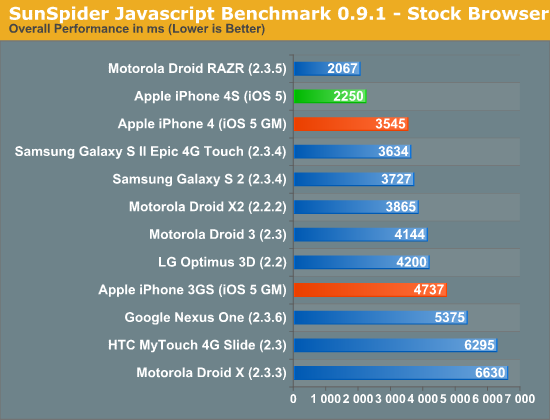
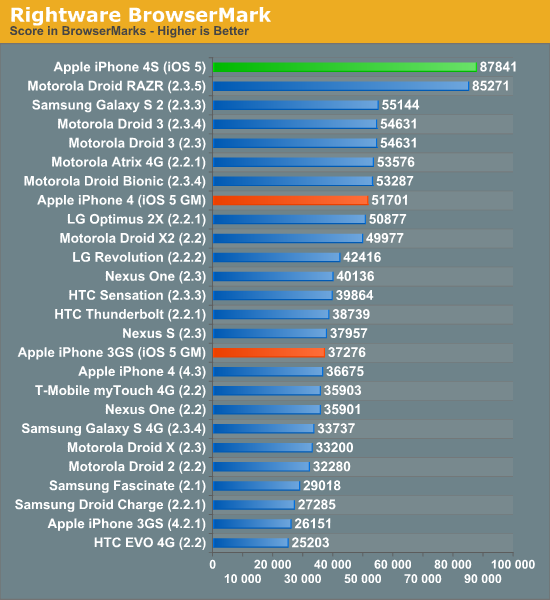
This translates directly into faster page load times. As you can see in the video below, the iPhone 4S (left) loads the AnandTech front page over WiFi in about 5 seconds compared to 9 seconds on the iPhone 4 (right). That's really the best case scenario, the improvement in the next page load time was only about a second (7s vs 8s).
Typical improvements in load time fall in the 10 - 70% range, contributing significantly to the phone feeling snappier than its predecessor. To quantify the improvement I ran through our standard web page loading suite, a test that hits AnandTech, CNN, NYTimes, Engadget, Amazon, Digg and Reddit hosted locally on our lab's network. The average page load time over WiFi for all of the pages is below:
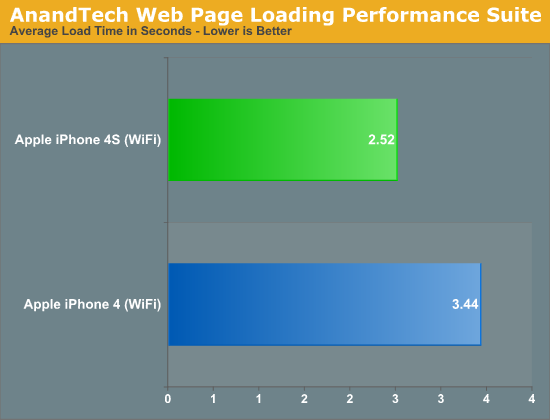
While web page rendering is a natural fit for multiple cores, I was surprised by how poorly threaded some apps ended up being. For example, although I did see performance improvements in exporting edited videos from the iOS version of iMovie, the gains weren't always evident. A quick profile of the app revealed that much of the export process is still single threaded. Just as we've seen on the desktop, there will be some added work necessary to get all apps to utilize multiple cores on iOS.
It's not always performance within an app that saw improvement with the A5: application install and launch times are also much quicker on the 4S. The time to launch Epic's iOS Citadel demo went from 32 seconds on the iPhone 4 to 22 seconds on the 4S. While the iPhone 4 may feel fast enough for many users, the 4S is noticeably faster.
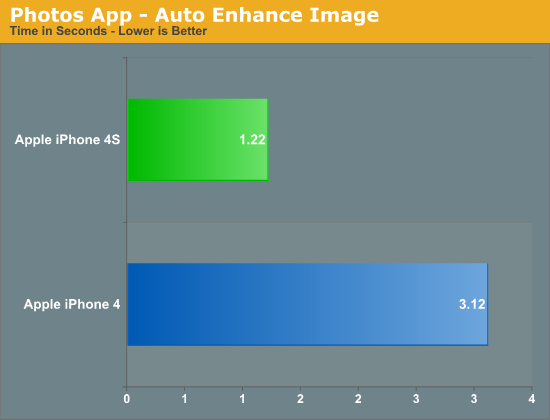
Much of the faster feel comes from by shaving off of seconds here or there. For example, I noticed apps like Messages pop up just slightly quicker on the 4S and you'll see your listing of messages a hair faster than you would on the 4. In the video above you get a brief idea of the sort of subtle improvements I'm talking about. YouTube launches a fraction of a second quicker on the 4S vs the 4.
These subtle decreases in response time are simply icing on the cake. The move from a 4 to a 4S is one of those upgrades that you'll notice right off the bat but will really appreciate if you go back to an iPhone 4 and try to use it. If you do a lot of web browsing on your phone, you'll appreciate the 4S.
I wasn't entirely sure whether or not I could attribute all of these performance improvements to the faster CPU. It's possible that some of the tests I mentioned are IO bound and Apple could have used faster NAND in the 4S. To find out I rounded up a bunch of iPhone 4Ses at all available capacities and measured sequential write speed:
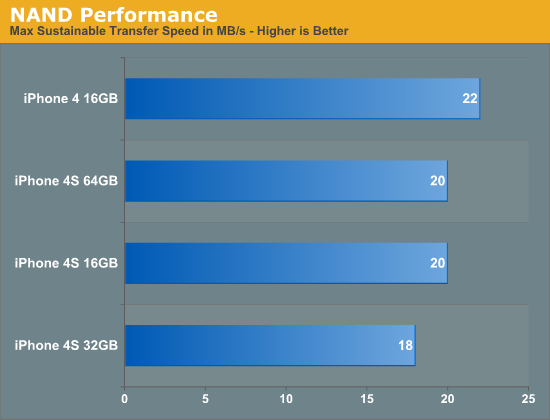
Apple uses multiple sources for NAND so it's possible that you'll see these numbers move around a bit depending on your particular phone. It looks like the iPhone 4S' NAND is no faster than what Apple shipped last year - at least in sequential write speed. The target appears to be 20MB/s and Apple does its best to stay around there. My iPhone 4 is actually pretty quick at 22MB/s but the advantage isn't significant enough to make a huge deal about. I don't have a good way of measuring random IO performance yet but application launch time is largely governed by sequential IO so I don't expect we're seeing gains from anything outside of the CPU and memory bandwidth in the earlier tests.


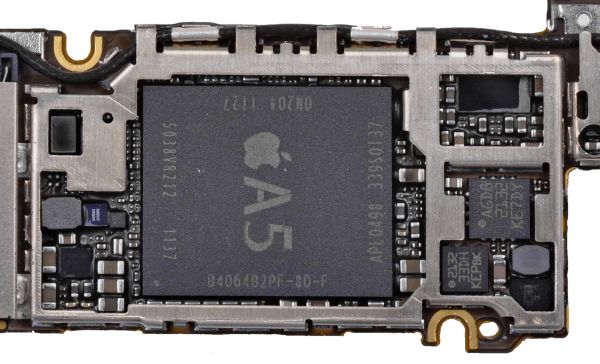








199 Comments
View All Comments
crankerchick - Tuesday, November 1, 2011 - link
Nice in depth review. AnandTech is the best place to get quality reviews. Thanks!Death666Angel - Tuesday, November 1, 2011 - link
I don't really see how a doubling of bandwidth (3GS->4->4s) is "more dramatic" than a tripling (3G->3GS). I am also not really impressed that smartphones now have the bandwidth of PCs from 7 years ago. After all, they have a great copy sheet.Soldier1969 - Tuesday, November 1, 2011 - link
If you already have a I4 this is NOT worth the upgrade! Waste of money. Much better options out there for a upgrade path the 4S isnt it...and Ive had the Iphone since release. This was a huge disappontment and failure for Apple. The only reason it sold as much as it did was all those people that still had the 3GS from 2 or 3 years ago or new customers. If you had a 4 already your just a "moop" if you upgraded to one of these!PeteH - Tuesday, November 1, 2011 - link
Depends what you are looking for in an upgrade. That graphics performance is pretty incredible. If you want to develop games pushing the boundaries of what is possible graphically on a mobile device the 4S makes a lot of sense.Lucian Armasu - Wednesday, November 2, 2011 - link
The graphics performance "in a benchmark". As you could see in the review, it only gets about double the FPS in real games, because it's bound by memory bandwidth.I doubt the games can run any faster or look any better than other current GPU's in mobiles.
thunng8 - Wednesday, November 2, 2011 - link
wow, what an absurd statement. Several games that were optimised for the new graphics increased their details level greatly and also added FSAA. You should have a look before passing judgement.*kjm - Tuesday, November 1, 2011 - link
Unless your like me and on Sprint comming from a Samsung M800 that is going on 4yrs old. I would think "most" people that can upgrade don't to stay off contract as long as the phone is working for them.doobydoo - Wednesday, November 2, 2011 - link
What would be a 'better option' right now, to upgrade an iPhone 4 to?Lucian Armasu - Wednesday, November 2, 2011 - link
The differences are not that big hardware wise at this point, so it will be more of a decision based on software. If you like iOS 5 you get an iPhone 4S, if you like Android 4.0, you get a Galaxy Nexus. If you like a different phone design, you get a Droid RAZR.I don't think the upgrade from iPhone 4 to iPhone 4S would be worth it anyway. Maybe from iPhone 3GS, for those who want to stay in the Apple ecosystem.
weiran - Wednesday, November 2, 2011 - link
> If you like a different phone design, you get a Droid RAZR.Which is ugly as sin, and isn't really an "upgrade" from an iPhone 4.
IMO from a design POV the most interesting iPhone competitor right now is the unreleased Nokia Lumia 800, for hardware and software.